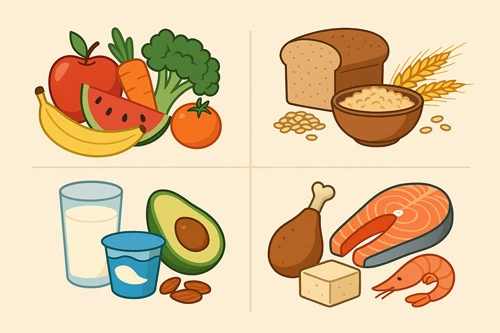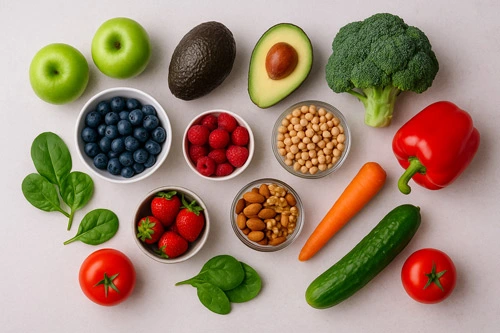Introduction
When we talk about healthy living, one of the most common questions people ask is, “How do you define balanced diet?” A balanced diet is more than just eating a mix of foods — it’s about providing your body with all the essential nutrients it needs in the right proportions to maintain health, energy, and overall well-being. Whether your goal is weight management, boosting immunity, or simply feeling more energetic, understanding what a balanced diet is can help you make smarter food choices every day.
In today’s fast-paced world, many people struggle to eat properly. Skipping meals, consuming too much processed food, and ignoring important food groups are all mistakes that can lead to nutrient deficiencies and long-term health problems. By learning how to define a balanced diet in both simple and detailed terms, you can start building a nutrition plan that works for your body, lifestyle, and goals.
This article will guide you step-by-step through everything you need to know. We’ll start with an easy definition for beginners (define balanced diet in short), then provide practical examples (define balanced diet with example), a complete balanced diet food list, and even a balanced diet chart you can follow at home. You’ll also see expert opinions on “what is your definition of a balanced diet?” and learn where to find a balanced diet PDF for easy reference. By the end, you’ll not only know the theory but also have the tools to put it into practice for a healthier, happier life.
Section 1: Define Balanced Diet – Detailed Definition
To define balanced diet in a comprehensive way, we first need to understand that “balance” in nutrition means consuming the right amounts of each nutrient group to meet your body’s needs. A balanced diet is not a one-size-fits-all plan — it varies depending on factors like age, gender, activity level, and health conditions. However, the core idea remains the same: your meals should supply carbohydrates, proteins, fats, vitamins, minerals, fiber, and adequate water in the proper proportions.
The World Health Organization (WHO) explains that a balanced diet includes a variety of foods from different food groups to ensure that the body receives a sufficient supply of essential nutrients. This means that no single food — no matter how healthy — can provide everything your body needs. Instead, variety is key. For example, whole grains provide energy and fiber, while fruits and vegetables offer vitamins and antioxidants, proteins help build and repair tissues, and healthy fats support brain and hormone function.
To define a balanced diet in practical terms, it’s helpful to think of it as a daily or weekly eating pattern that:
-
Provides energy for daily activities and bodily functions.
-
Supports growth and repair of cells, muscles, and tissues.
-
Strengthens the immune system to fight off illnesses.
-
Prevents nutritional deficiencies and reduces the risk of chronic diseases like diabetes, heart disease, and obesity.
For example, if you were to create a balanced diet chart, it might include:
-
40–60% carbohydrates from sources like whole grains, fruits, and vegetables.
-
20–35% healthy fats from nuts, seeds, avocados, and oils like olive or flaxseed oil.
-
10–35% protein from lean meats, fish, eggs, dairy, legumes, and plant-based sources.
When people ask “what is balance diet?”, the answer is not just about the nutrients but also about moderation and variety. Even healthy foods can become unhealthy if eaten in excess, while small amounts of less healthy foods can be part of a balanced plan when enjoyed occasionally.
Ultimately, to define balanced diet is to describe an eating pattern that meets your nutritional requirements, keeps you satisfied, and supports long-term health without unnecessary restriction or overindulgence.
learn more: pegan diet: Menus, Food Lists, Plans & Recipes
Section 2: Define Balanced Diet in Short – Quick & Simple Explanation
If we want to define balanced diet in short, we can say:
A balanced diet is eating the right amounts of different foods so your body gets all the nutrients it needs to stay healthy and active.
That’s it — simple and easy to remember. This short definition works well for school students, beginners in nutrition, or anyone who just wants a quick explanation without complicated science.
In everyday life, this means including a variety of foods from the main food groups — carbohydrates, proteins, fats, vitamins, minerals, and water — in the correct proportions. You don’t have to count every nutrient every day, but you should aim to eat meals that include colorful vegetables, fresh fruits, whole grains, healthy proteins, and small amounts of good fats.
For example, a balanced diet in short could look like:
-
Breakfast: Whole-grain toast with eggs and fruit.
-
Lunch: Grilled chicken salad with vegetables and olive oil.
-
Dinner: Brown rice, steamed vegetables, and fish.
-
Snacks: Nuts, yogurt, or fresh fruit.
By keeping this simple definition in mind, you can quickly decide whether your daily meals are balanced or if you need to add more variety and nutrients.
Section 3: Define Balanced Diet with Example
When we define balanced diet with example, it becomes much easier to understand and apply in real life. A definition tells us what a balanced diet is, but an example shows us how it works in practice.
A balanced diet combines foods from all essential food groups — carbohydrates, proteins, fats, vitamins, and minerals — in the right proportions. It also includes adequate water to keep the body hydrated and functioning properly. Here’s a simple one-day balanced diet example that can guide you:
Breakfast
-
Whole-grain oatmeal topped with fresh berries and a spoonful of nuts.
-
Low-fat milk or a plant-based alternative.
Why it’s balanced: The oats provide complex carbohydrates and fiber, the berries add vitamins and antioxidants, the nuts offer healthy fats, and the milk supplies protein and calcium.
Mid-Morning Snack
-
Apple with a tablespoon of peanut butter.
Why it’s balanced: The apple offers fiber and vitamins, while the peanut butter contains protein and healthy fats.
Lunch
-
Grilled chicken breast with quinoa and a large salad of leafy greens, tomatoes, cucumbers, and olive oil dressing.
Why it’s balanced: Chicken delivers lean protein, quinoa adds complex carbs and minerals, vegetables supply essential vitamins, and olive oil provides healthy fats.
Afternoon Snack for define balanced diet
-
Greek yogurt with sliced banana.
Why it’s balanced: Yogurt gives protein and probiotics for gut health, while bananas provide potassium and natural sweetness.
Dinner
-
Baked salmon with brown rice and steamed broccoli.
Why it’s balanced: Salmon offers omega-3 fatty acids and protein, brown rice gives slow-releasing carbs, and broccoli is rich in fiber, vitamins, and minerals.
Evening Option (if hungry)
-
A handful of unsalted almonds or herbal tea with whole-grain crackers.
This example shows that a balanced diet is not about complicated recipes or expensive foods — it’s about combining nutrient-rich ingredients in the right proportions. By following such examples, you can adapt your meals to match your tastes, culture, and health needs while still meeting the core principles of a balanced diet.
learn more: Mediterranean Diet: A Complete Guide to Principles, Meal Plans, Recipes
Section 4: Balanced Diet Food List – Essential Foods for Every Meal
Creating a balanced diet food list helps you plan meals more easily and ensures you include all the necessary nutrients. A balanced diet should contain foods from six main groups: carbohydrates, proteins, fats, vitamins, minerals, and water. Below is a detailed list to guide you in making healthier choices every day.
1. Carbohydrate Sources (Energy Providers)
Carbohydrates are your body’s main source of fuel. Choose complex carbs for long-lasting energy instead of refined sugars.
-
Whole grains: brown rice, quinoa, oats, barley, whole wheat bread, whole wheat pasta
-
Starchy vegetables: sweet potatoes, corn, pumpkin
-
Legumes: lentils, chickpeas, black beans
-
Fruits: apples, bananas, berries, oranges, pears
2. Protein Sources (Body Builders)
Proteins help repair tissues, build muscles, and support immune function.
-
Lean meats: chicken breast, turkey, lean beef
-
Fish and seafood: salmon, tuna, mackerel, shrimp
-
Dairy: milk, yogurt, cheese
-
Plant-based: tofu, tempeh, edamame, lentils, beans
3. Healthy Fat Sources (Nutrient Absorbers & Energy Reserves)
Healthy fats are vital for brain function, hormone production, and vitamin absorption.
-
Nuts: almonds, walnuts, cashews
-
Seeds: chia seeds, flaxseeds, sunflower seeds
-
Healthy oils: olive oil, avocado oil, coconut oil (in moderation)
-
Avocados, fatty fish, olives
4. Vitamins & Mineral Sources (Body Regulators)
These nutrients protect against disease, support cell functions, and keep your body working smoothly.
-
Vegetables: spinach, kale, carrots, broccoli, bell peppers
-
Fruits: kiwi, papaya, grapes, citrus fruits
-
Dairy and fortified plant-based milks for calcium
-
Nuts, seeds, and whole grains for magnesium and zinc
5. Hydration (Water – The Forgotten Nutrient)
Water is essential for digestion, circulation, temperature regulation, and nutrient transport.
-
Plain water (6–8 glasses daily)
-
Herbal teas (without added sugar)
-
Water-rich foods like cucumbers, watermelon, and oranges
Tip: A balanced diet food list is not fixed — you can adapt it to your culture, budget, and preferences while keeping the same nutrient principles. Aim for variety, moderation, and minimal processing to get the best health results.
learn more: Plant-Based Diet: A Complete Guide to Benefits, Foods & Weight Loss
Section 5: Balanced Diet Chart – A Visual Guide
A balanced diet chart is a simple yet effective tool that helps you organize your daily or weekly meals to ensure you’re getting the right proportions of all essential nutrients. Instead of guessing what to eat, a diet chart offers a visual plan to balance carbohydrates, proteins, fats, vitamins, and minerals throughout the day.
Why Use a Balanced Diet Chart in define balanced diet
-
Simplifies meal planning: You can easily see how much of each food group to include.
-
Encourages variety: Ensures no nutrient group is neglected.
-
Promotes portion control: Helps avoid overeating or under-eating.
-
Supports specific health goals: You can adjust the chart based on weight loss, muscle gain, or maintenance.
Sample Balanced Diet Chart (Daily Plan)
| Food Group | Percentage of Daily Intake | Examples | Meal Suggestions |
|---|---|---|---|
| Carbohydrates | 45–60% | Whole grains, fruits, vegetables | Brown rice, whole-wheat bread |
| Proteins | 15–30% | Lean meats, fish, legumes, dairy | Grilled chicken, lentil soup |
| Fats | 20–35% | Nuts, seeds, olive oil, fatty fish | Olive oil dressing, salmon |
| Fruits & Vegetables | 25–35% (by volume) | Fresh, colorful veggies and fruits | Spinach salad, mixed berries |
| Water | 6–8 glasses/day | Plain water, herbal tea | Drink throughout the day |
How to Use This Chart
-
Aim to fill half your plate with fruits and vegetables.
-
Choose whole grains over refined carbs.
-
Include a source of protein at each meal.
-
Use healthy fats in moderation.
-
Stay hydrated throughout the day.
Using a balanced diet chart helps remove confusion about what to eat and when. You can customize this chart to fit your lifestyle, preferences, and dietary needs. It also makes it easier to track your intake and make healthier choices consistently.
Section 6: What Is Your Definition of a Balanced Diet? – Expert & Personal Views
The question, “What is your definition of a balanced diet?” can have slightly different answers depending on who you ask. Nutrition experts, dietitians, and health professionals often tailor their definitions based on individual needs, cultural factors, and health conditions.
Expert Definitions
Most nutritionists agree that a balanced diet involves consuming a variety of foods in the right amounts to meet your body’s nutritional requirements without excess calories. According to the Academy of Nutrition and Dietetics, a balanced diet:
-
Includes all major food groups — carbohydrates, proteins, fats, vitamins, minerals, and water.
-
Emphasizes whole, minimally processed foods.
-
Encourages portion control and mindful eating.
Personalized Views
While the general principles remain consistent, your personal definition of a balanced diet might depend on factors such as:
-
Age: Children, adults, and seniors have different nutritional needs.
-
Activity Level: Athletes may require more protein and calories, while sedentary individuals might need fewer.
-
Health Status: Those with medical conditions like diabetes or heart disease may follow specific diet modifications.
-
Cultural Preferences: Traditional foods and eating patterns play a role in defining a balanced diet for different communities.
Why This Matters
Understanding what is your definition of a balanced diet? encourages you to think critically about your own eating habits and how they fit your lifestyle. It also highlights the importance of flexibility and personalization in nutrition — no single diet fits everyone perfectly.
Section 7: What Is a Balanced Diet PDF? – Free Download & Resources
Many people search for a balanced diet PDF to have an easy-to-follow guide that outlines the principles of a healthy eating plan. These PDFs often include detailed food lists, meal plans, and charts that help individuals stick to a balanced diet more conveniently.
Accessing a well-designed balanced diet PDF can simplify your journey toward better nutrition by providing clear examples and practical tips in one downloadable document. Numerous reputable health organizations and nutritionists offer such resources online for free.
Using a balanced diet PDF as a reference can keep you motivated and ensure you’re meeting your dietary needs consistently.
Section 8: Benefits of a Balanced Diet – Why It Matters
A well-planned and balanced diet offers numerous benefits that contribute to both short-term and long-term health. Understanding these benefits helps motivate people to adopt and maintain healthier eating habits. When you consistently follow a balanced diet, your body receives all the essential nutrients it needs to function properly, repair itself, and stay protected against diseases.
Physical Health Benefits
Eating a balanced diet supports maintaining a healthy body weight by providing the right amount of calories and nutrients. It helps regulate metabolism and reduces the risk of chronic diseases such as heart disease, type 2 diabetes, hypertension, and certain types of cancer. Nutrients like calcium and vitamin D strengthen bones and teeth, while protein aids muscle growth and repair. Balanced nutrition also improves digestion and promotes regular bowel movements thanks to sufficient fiber intake from fruits, vegetables, and whole grains.
Mental and Emotional Well-being
A balanced diet does more than just benefit the body — it also has a profound effect on mental health. Nutrient-rich foods containing omega-3 fatty acids, B vitamins, and antioxidants can enhance brain function, improve memory, and elevate mood. Studies show that people who eat balanced diets are less likely to experience depression, anxiety, and cognitive decline. Eating regularly balanced meals helps stabilize blood sugar levels, preventing mood swings and fatigue.
Energy and Vitality
Fueling your body with a balanced diet means you get steady energy throughout the day. Complex carbohydrates provide lasting energy, while proteins and fats support cellular repair and hormone production. Without balanced nutrition, you might experience fatigue, weakness, or difficulty concentrating. Proper hydration, another critical part of a balanced diet, ensures that your body’s systems work efficiently and helps prevent dehydration-related tiredness.
Stronger Immune System
A diet rich in vitamins and minerals like vitamin C, zinc, and iron strengthens your immune system, helping your body fight infections and recover faster from illnesses. Balanced nutrition supports the production of antibodies and white blood cells, which are essential for defending against harmful pathogens. This is especially important during flu seasons or pandemics when a strong immune response is crucial.
Long-Term Health and Longevity
Consistently following a balanced diet contributes to a longer, healthier life by preventing lifestyle-related diseases and promoting overall wellness. It also enhances quality of life by supporting mobility, cognitive function, and mental clarity as you age.
By understanding these comprehensive benefits, it becomes clear why it’s essential to define balanced diet not just as a concept but as a practical lifestyle choice that significantly impacts your health and happiness.
Section 9: Common Mistakes People Make in Following a define balanced diet
Even though many people understand the importance of a balanced diet, several common mistakes can prevent them from fully benefiting. Recognizing these pitfalls is the first step to improving your eating habits and truly achieving a balanced diet.
1. Skipping Meals
Some believe skipping meals helps with weight control, but it often leads to overeating later and disrupts metabolism. Eating regular, balanced meals maintains energy levels and prevents excessive hunger.
2. Overconsuming Processed Foods
Relying heavily on processed and fast foods, which are often high in unhealthy fats, sugars, and salt, undermines the principles of a balanced diet. These foods lack essential nutrients and can contribute to chronic diseases.
3. Ignoring Portion Sizes
Even healthy foods can cause weight gain if eaten in large amounts. A balanced diet requires mindful portion control to avoid excessive calorie intake.
4. Lack of Variety
Eating the same few foods repeatedly limits the range of nutrients you receive. A balanced diet emphasizes variety to ensure comprehensive nutrition.
5. Neglecting Hydration
Many forget that water is a vital part of a balanced diet. Insufficient hydration can lead to fatigue, headaches, and poor digestion.
6. Overemphasis on One Nutrient
Focusing too much on one nutrient (like protein or carbs) while neglecting others disrupts balance. All nutrient groups must be included in proper proportions.
7. Relying on Supplements Instead of Food
Supplements can help fill gaps but should not replace nutrient-rich whole foods, which provide fiber and additional benefits.
Conclusion define balanced diet
In summary, to define balanced diet is to understand the importance of consuming a variety of nutrient-rich foods in the right proportions to support overall health and well-being. A balanced diet fuels your body, strengthens your immune system, enhances mental clarity, and reduces the risk of chronic diseases.
By following practical examples, using food lists, and referring to diet charts, anyone can create a personalized and sustainable eating plan. Avoiding common mistakes and adapting your diet to your unique needs ensures long-term success.
Remember, a balanced diet is not about strict restrictions but about making informed, healthy choices every day. Embrace balance and variety for a healthier, happier life.
Frequently Asked Questions (FAQs)
1. What does it mean to define balanced diet?
A balanced diet means eating a variety of foods in the right amounts to provide your body with essential nutrients for good health.
2. How can I define balanced diet in short?
Simply put, it’s eating different kinds of healthy foods in the right proportions every day.
3. Can you give me an example to define balanced diet?
Yes, a balanced diet example includes meals with whole grains, lean proteins, healthy fats, fruits, and vegetables throughout the day.
4. What foods should be included in a balanced diet food list?
Fruits, vegetables, whole grains, lean proteins like chicken and fish, healthy fats like nuts and olive oil, and dairy or alternatives.
5. How does a balanced diet chart help?
A balanced diet chart visually shows how much of each food group you should eat daily for proper nutrition.
6. Why is it important to have a balanced diet?
It supports overall health, boosts energy, strengthens the immune system, and helps prevent diseases.
7. Where can I find a balanced diet PDF?
Many health websites and nutrition organizations offer free downloadable balanced diet PDFs online.
8. What is the difference between a balanced diet and a healthy diet?
A balanced diet focuses on the right proportions of nutrients, while a healthy diet emphasizes overall food quality and nutrient density.
9. How often should I follow a balanced diet?
Ideally, every day, to maintain consistent nutrition and health benefits.





